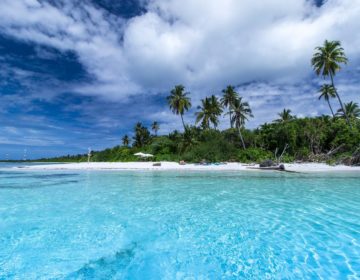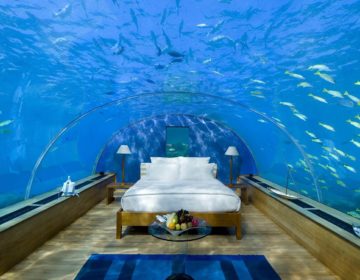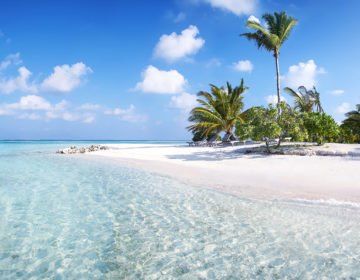South Nilandhe Atoll has quite a few channels that allow long drift dives, a couple of deep water thilas, and plenty of shallow reefs ideal for beginner divers, snorkeling and night dives. There are several uninhabited islands with excellent snorkeling that are ideal for day excursions. There are 10 channels on the eastern side and five on the western side. Some of the channels, like Fushi Kandu – the only protected marine area in the atoll – are wide and relatively shallow with more than one thila across the entrance. Inside the channel entrance, the bottom is mostly sandy and between 30 and 40 meters in depth.

Fushi Kandu – PROTECTED MARINE AREA
This is an exceptional dive with five thilas across the one-kilometer-wide channel. The thilas are mostly long and narrow and rise from a sandy bottom of 20 to 25 meters. Depth drops to 30 meters once inside the channel and the outside ledge drops steeply away from 30 meters. Divers can take a look at the outside drop-off for sharks, eagle rays and other big fish and if they return to the thilas and keep a relatively low profile, then a leisurely dive across the entire channel can be made. This allows plenty of opportunity to see the sandy channels with stingrays and possibly nurse sharks. The thilas attract any schools of fish, as well as moray eels.
 The sandy channels are home to stingrays and nurse sharks (above).
The sandy channels are home to stingrays and nurse sharks (above).
Velavaru Thila
Velavaru Thila is made up of three main thilas: Bodu Thila, Kuda Thila, and Beyru Thila.
Beyru Thila is closest to the outside of the atoll and is a good starting point with an incoming current. Seas can get quite rough in this wide channel and currents can be fickle, however, when conditions are settled, this is an extremely exciting dive with large schools of colorful fish and many invertebrates. The top of the three thilas varies from seven to ten meters and each one is alive with colorful fusiliers, snapper, fairy basslets, hydroids, sponges and soft corals. Turtles are regularly seen grazing on the reef. Bodu Thila is quite large and divers will often start on the north side of this thila and drift northwest across sand to Kuda Thila, past sand eels and often resting white-tip reef sharks.
 The sandy bottom is covered in gardens of winding sand eels.
The sandy bottom is covered in gardens of winding sand eels.
Kuda Thila is about 75 meters across and there are two caves on the southern side at 13 and 25 meters that are full of sponges. There are also harlequin or spotted sweetlips, big-eyes and lobsters. In the deeper cave are two large sea fans, as well as soft corals. There are more caves on the northwest and northeast sides at 20 meters with black coral sea whips nearby. On the sandy bottom are arrow dart gobies, sand eels, sea cucumbers and sea stars. This dive has it all and is one of the diving highlights of the atoll.
![]()
 On the sandy bottom are sea cucumbers.
On the sandy bottom are sea cucumbers.
Lhohi Caves
This is a delightful dive with a wide range of invertebrates ideal for photographers and marine naturalist studies. There are a series of caves starting at five meters and descending to 20 meters that are lined with sponges of all colors and size and plenty of stony coral. The caves occur over a distance of about 200 meters and can be comfortably dived at a leisurely pace. Inside are banded shrimp, giant spaghetti worms, lobster and slipper lobster, with shells including turban, tiger cowries, and thorny oysters. There are also numerous sea stars, feather stars, urchins, and opisthobranchs. This is also an excellent night dove location and can be dived in most conditions.
 Lhohi Caves are home to giant spaghetti worms.
Lhohi Caves are home to giant spaghetti worms.
Maale Faru
Maale Faru is a reef dive off the island of Maalefaru. It features a long, wide thila that extends into the channel on the north side. The top is mostly flat between 16 and 20 meters with some healthy hard corals on the top and on the outside at the channel entrance. There are feather stars, plenty of goatfish, fusiliers, and many stands of green coral trees, commonly called midnight coral (Tubastrea micrantha).
 There are many stands of green coral trees, commonly called midnight coral (Tubastrea micrantha).
There are many stands of green coral trees, commonly called midnight coral (Tubastrea micrantha).
Hulhu Kandu
Hulhu Kandu is a channel with a ridge across the depth of around 15 to 20 meters. There are a number of small thilas that provide an interesting terrain for divers wishing to cross the channel. This should only be attempted when conditions are favourable as the current can become quite strong here. A recess in the reef on the southern side provides in interesting and slightly protected area with an outcrop of reef inside.

(Source: Dive Maldives: A Guide to the Maldives Archipelago. Tim Godfrey. Atoll Editions, 2015)



